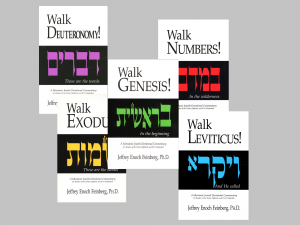In a few weeks it will be time to restart the Torah reading cycle. Every year at the conclusion of Sukkot, the Feast of Tabernacles, we celebrate Simchat Torah, a Hebrew phrase that means “rejoicing in the Torah.” The final Torah portion in Devarim (Deuteronomy) is read. If an actual Torah scroll is used, it is rolled back to the beginning. Then the cycle is re-started by reading the first few verses of the beginning of Bereshit (Genesis). The “year” for Torah reading begins on the first Sabbath following Sukkot.
This year, in the Gregorian year AD2018, Simchat Torah will fall on Tuesday, October 2. The first Torah portion Bereshit is read on Sabbath, October 6, which is 27 Tishrei 5779 on the Hebrew calendar. Will you be ready?
Free Resources
Each week I post the Torah readings on the Messianic Torah Portion web site, https://messianictorahportion.com. These posts include the weekly Parashat along with the Haftarah readings following both the Ashkenazi and Sephardic traditions. These are taken from the Stone Edition Chumash, a traditional Jewish standard. In addition, I include a reading from the Brit Chadasha, the New Testament. For this coming cycle, those readings will come from the Walk! series of Messianic devotionals books discussed a little further down.
These are also listed on a regular Gregorian calendar here, along with Scripture readings for the Biblical Appointed Times, often called The Feasts. However, I would encourage you during this Torah reading cycle to think according to the Biblical months on the Hebrew calendar. I’ve included one here that you can view online or download and print for yourself. Rather than being a Gregorian calendar superimposed with Hebrew dates, these are Hebrew months with the Gregorian date as a reference.
Walk! Series Messianic Devotionals
 These books by Dr. Jeffrey Feinberg are a great resource for believers in Yeshua who wish to study using the traditional Torah cycle. Each parashat is further broken down according to tradition, and when combined with the Haftarah and Brit Chadasha readings they offer a well-organized method that can also be used for daily study. These can be purchased one at a time as you go through the year if you don’t want to get all five at once. The Brit Chadasha readings that I post at Messianic Torah Portion are taken from this series. Go here for a more extensive review I did of these books.
These books by Dr. Jeffrey Feinberg are a great resource for believers in Yeshua who wish to study using the traditional Torah cycle. Each parashat is further broken down according to tradition, and when combined with the Haftarah and Brit Chadasha readings they offer a well-organized method that can also be used for daily study. These can be purchased one at a time as you go through the year if you don’t want to get all five at once. The Brit Chadasha readings that I post at Messianic Torah Portion are taken from this series. Go here for a more extensive review I did of these books.
5-minute Torah

This is a newer resource, written in 2017, and I haven’t yet used it for a complete Torah cycle so I am looking forward to this year. I have this as an e-book on my Kindle e-reader which I find very convenient alongside my Bible. There is a chapter for each Torah portion that can be read, as the title suggests, in about five minutes. Click on the picture to see this book at Amazon.
The author, Darren Huckey, says he draws on “insights of classic commentators such as Rashi, Rambam, Ramban, etc. Many insights have been gleaned from Chassidic interpretation as well. However, since my perspective is through the lens of the teachings of Yeshua of Nazareth and his Apostles, my insights may take a different dimension than the original interpretation. I will often use traditional interpretations as a springboard for additional insights that have relevant meaning to followers of Yeshua.” I think he has done this successfully.
Use a Different Bible
Especially if this isn’t your first time through the Torah cycle, try using a different translation of the Bible than you normally read. I’ve reviewed a few Messianic translations here, but you don’t necessarily need one of these. Just reading from a different translation you may notice something you haven’t seen in previous years, or it may cause you to question why something is translated a certain way – which, of course, you will want to search out.
Please make sure you are reading the portions from a printed copy of the Scriptures. I have noticed so many people coming to services or meetings and reading the Bible on their cell phones. You are more likely to read consistently, retain what you read and be able to go back if you want to recall something you saw if you are using printed materials. There may even come a time when technology fails to work.
If finances are a concern, check Goodwill, the Salvation Army or a local used book store or thrift store. Some of these may have a policy of not charging for Bibles, or you may be able to find a translation you don’t have for a very low price. If you are looking at the Amazon links I have provided on this site but find the prices unaffordable, be sure you check the used or surplus copies that may be available using the link on the right side of the Amazon page.
I acknowledge that I am writing this living in the United States and I am very thankful for the freedom afforded in this country. We are so blessed here with easy access to the Word of God that we too often take it for granted.
Make your commitment now that you will read and study the Torah portions this year. The new cycle will begin right after Sukkot. Now is the time to prepare and have everything ready to start.

